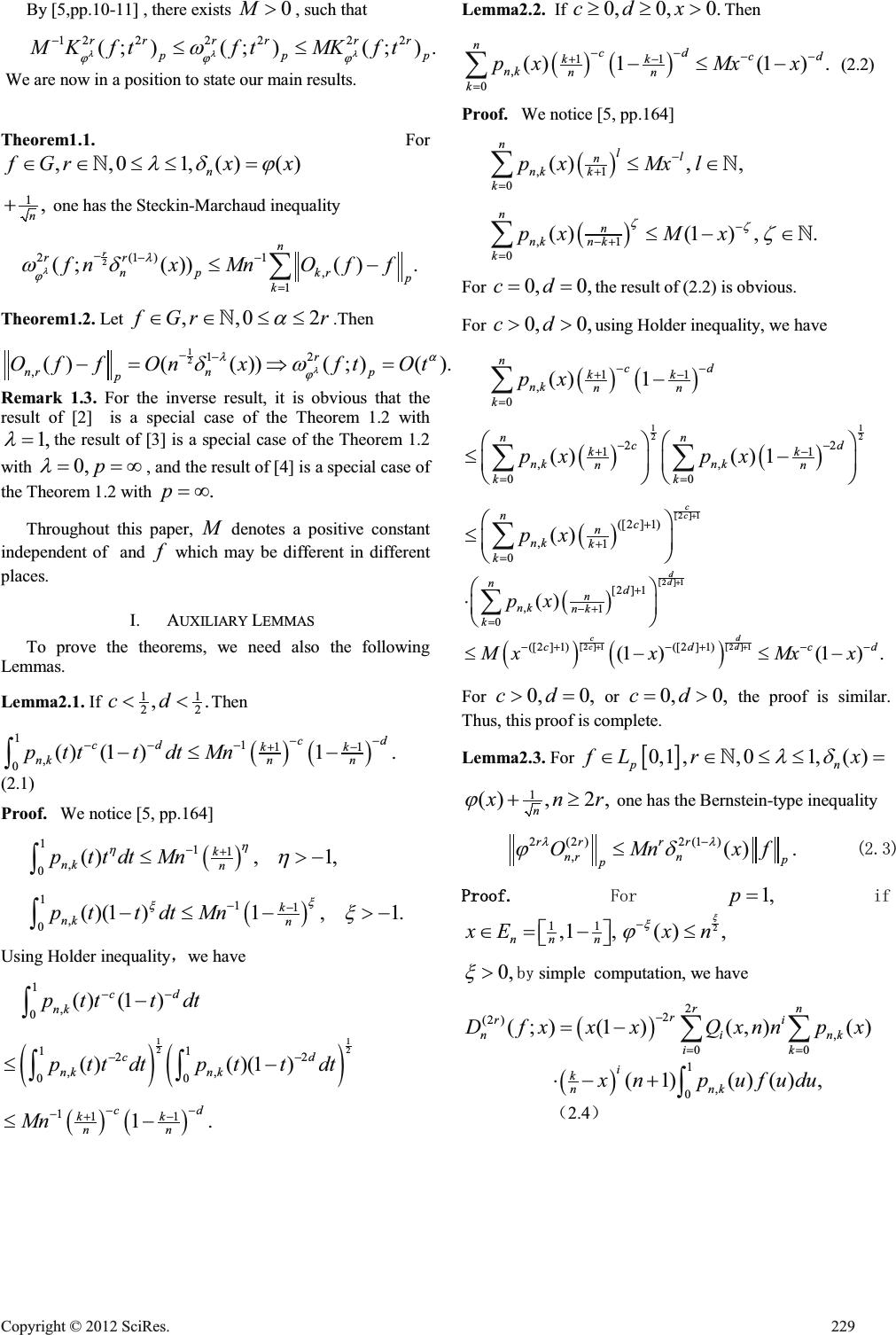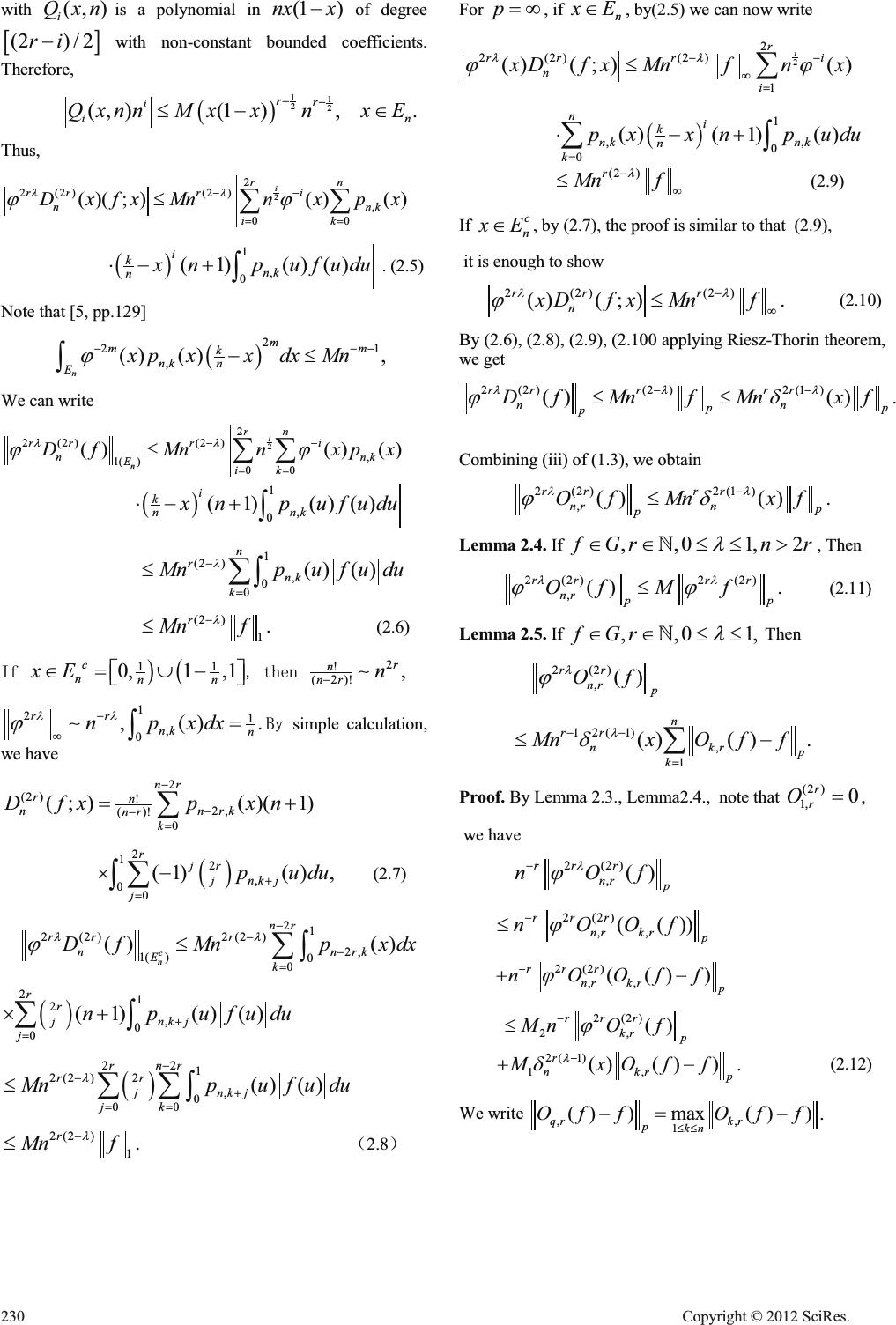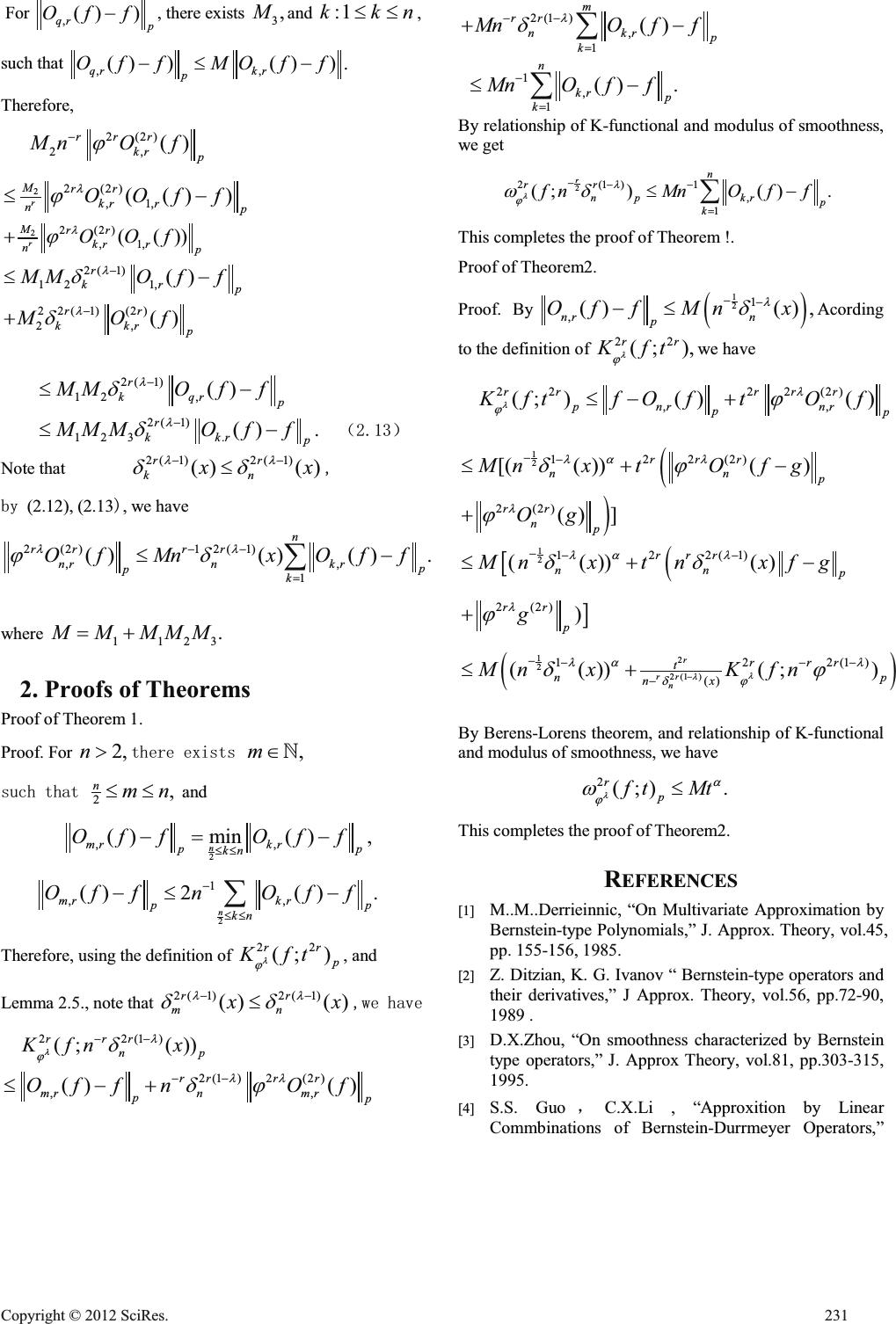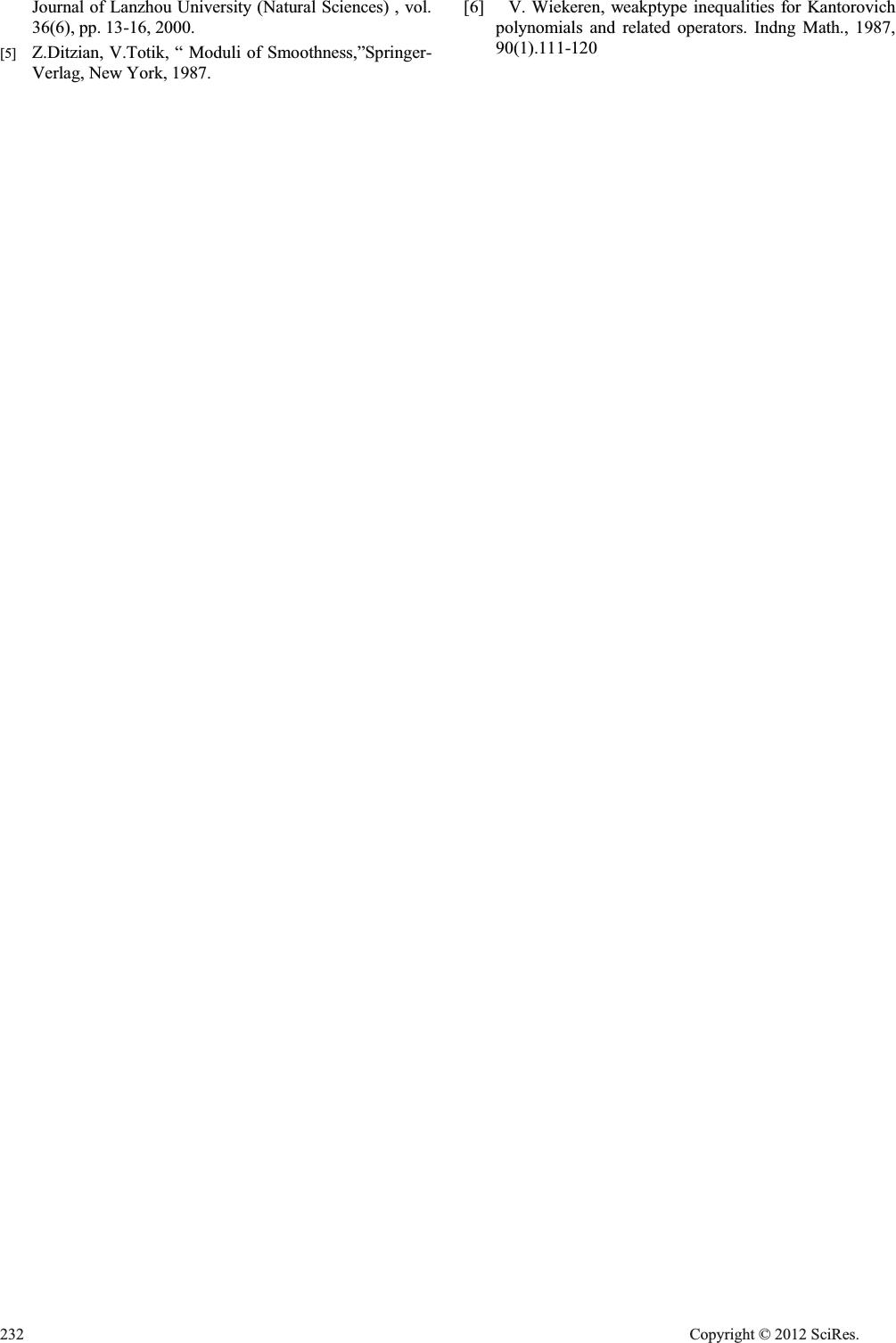Paper Menu >>
Journal Menu >>
 Stechkin-Marchaud Type Inequalities in Lpfor Linear Combination of Bernstein-Durrmeyer Operators Guo Feng1 1.School of Mathematics and Information Engineering, Taizhou University, Zhejiang,Taizhou 317000, China e-mail : gfeng@tzc.edu.cn Meiqin Ke2 2.Library, TaizhouUniversity, Zhejiang,Taizhou 317000, China e-mail :mqke@tzc.edu.cn Abstract—In this paper, we use the equivalence relation between K-functional and modulus of smoothness, and give the Stechkin-Marchaud-type inequalities forlinear combination of Bernstein-Durrmeyer operators . Moreover, we obtain the inverse result of approximation for linear combination of Bernstein-Durrmeyer operators with2(;) rfx O M Z . Meanwhile we unify and extend some previous results. Keywords- Bernstein-Durrmeyer operators; linear combination; K-functional;Stechkin-Marchaud-type inequalities; modulus of smoothness 1. Introduction and Main Results Let >@ 0,1 ,(1) p fL pddf . The Bernstein- Durrmeyer operator (;)( : n Dfxn ` set of naturals ) is defined as follows 1 ,, 0 0 (;)( )(1)()(), n nnknk k Dfxpxnp tftdt ¦³ (1.1) where ,()(1) . nk nk nk k pxx x which was first introduced and investigated by Derrieinnic[1] in 1985. The Linear combination of Bernstein-Durrmeyer operators given by 21 , 0 (;)() (;), i r nri n i Ofx cnDfx ¦ (1.2) where i nand () i cnsatisfy: 21 01 21 0 ),)()1, r rn i i in nnnciicn ddddd ¦ " 21 0 )(), r i i iiicnM d ¦ 21 0 )()(();)0,1, 2,, 21. i r m in i ivcnDtxxmr ¦ " (1.3˅ Ditzian and Ivanov [2], Zhou [3], Guo and Li [4] studied the Linear combination of Bernstein-Durrmeyer operators, and obtained the characterization of approximation, the relationship of differential and modulus of smoothness for , (;) nr Ofx . In this paper, we first establish Bernstein-type inequality with parameter O for , (;) nr Ofx . After that, we use the equivalence relation between K-functional and modulus of smoothness, and give the Stechkin-Marchaud type inequalities in >@ 0,1 p fLfor linear combination of Bernstein-Durrmeyer operators. Moreover, we obtain the inverse result of approximation for linear combination of Bernstein-Durrmeyer operators with 2(;) rfx O M Z . Meanwhile we unify and extend [2-4] results. First, we introduce some useful definitions and notations. Definition1.1. Let 2 ()(1 ),01,1.xx xp MO ddddf The modulus of smoothness by 22 0 (; )sup, rr php ht ft f OO MM Z d ' where >@ 222 0 ()(1) (()),,0,1, r rk rh rh r h k r fxfxkh xx k §· ' ªº ¨¸ ¬¼ ©¹ ¦ otherwise () 0. r h fx' The K-functional by ^` 22 22(2) ( ;)inf, rr rrr ppp gG Kftfgtg O O MM where >@ >@ ^` (21)2(2) 0,1 ,..,0,1. rrr ploc p GggLgACg L O M Project supported by the Zhejiang Provincial Natural Science Foundation (No.LY12A01008) and the Cultivation Fund of Taizhou University. Open Journal of Applied Sciences Supplement:2012 world Congress on Engineering and Technology 228 Cop y ri g ht © 2012 SciRes.  By [5,pp.10-11] , there exists 0M! , such that 12 22 22 2 (; )(; )(; ). rr rrrr pp p MK ftftMKft OO O MM M Z dd We are now in a position to state our main results. Theorem1.1. For ,,0 1,()() n fGrx x OG M dd ` 1 , n one has the Steckin-Marchaud inequality 2 2(1) 1 , 1 (;())() . rn rr npkr p k fnxMnO ff O O M ZG d ¦ Theorem1.2. Let ,,0 2fGr r D dd` .Then 1 2 12 , ()(())(; )(). r nrn p p Of fOnxftOt O OD M GZ Remark 1.3.For the inverse result, it isobvious that the result of [2] is a special case of the Theorem 1.2 with 1, O the result of [3] is a special case of the Theorem 1.2 with 0, p O f , and the result of [4] is a special case of the Theorem 1.2 with .p f Throughout this paper, M denotes a positive constant independentof and fwhich may be different in different places. I. AUXILIARY LEMMAS To prove the theorems, we need also the following Lemmas. Lemma2.1. If 11 22 ,.cd Then 1111 , 0 () (1 )1. cd cd kk nk nn pt ttdtMn d ³ (2.1) Proof. We notice [5, pp.164] 111 , 0(), 1, k nk n pttdtMn K KK d! ³ 111 , 0 ()(1)1,1. k nk n pt tdtMn [ [ [ d ! ³ Using Holder inequalityˈwe have 1 , 0() (1 ) cd nk ptt tdt ³ 11 22 11 22 ,, 00 ()()(1) cd nk nk pttdtptt dt d ³³ 111 1. cd kk nn Mn d Lemma2.2. If 0,0, 0.cd xtt! Then 11 , 0 ()1(1) . ncd cd kk nk nn k pxMx x d ¦ (2.2) Proof. We notice [5, pp.164] ,1 0 (), , nll n nk k k px Mxl d ¦ ` ,1 0 ()(1) ,. n n nk nk k pxM x ]] ] d ¦ ` For 0, 0,cd the result of (2.2) is obvious. For 0, 0,cd!! using Holder inequality, we have 11 , 0 () 1 ncd kk nk nn k px ¦ 11 22 22 11 ,, 00 () ()1 nn cd kk nk nk nn kk px px §·§ · d ¨¸¨ ¸ ©¹© ¹ ¦¦ [2] 1 ([2]1) ,1 0 () c c nc n nk k k px §· d¨¸ ©¹ ¦ [2] 1 [2] 1 ,1 0 () d d nd n nk nk k px §· ¨¸ ©¹ ¦ [2] 1[2] 1 ([2 ] 1)([2] 1) (1 )(1 ). cd cd cdcd MxxMx x dd For 0, 0,cd! or 0, 0,cd ! the proof is similar. Thus, this proof is complete. Lemma2.3. For >@ 0,1 ,,01,() pn fL rx OG dd ` 1 (), 2, n xnr M t one has the Bernstein-type inequality 2(2)2(1 ) , () . rr rr nr np p OMnxf OO MG d 3URRI )RU 1,p LI 11 ,1 , nnn xE ªº ¬¼ 2 () ,xn [ [ M d 0, [ ! E\ simplecomputation, we have 2 2 (2) , 00 (;)(1)(,)() rn r ri nink ik Dfxxx Qxnnpx ¦¦ 1 , 0 (1) ()(), i k nk n xn pufudu ³ ˄2.4˅ Cop y ri g ht © 2012 SciRes.229  with (,) i Qxn is a polynomial in (1 )nx x of degree >@ (2) / 2ri with non-constant bounded coefficients. Therefore, 11 22 (,)(1 ),. rr i in QxnnMxxnx E d Thus, 2 2 2(2) (2) , 00 ()( ;)()() i rn rrr i nnk ik DxfxMnn xpx OO MM d ¦¦ 1 , 0 (1) ()() i k nk n xn pufudu ³ . (2.5) Note that [5, pp.129] 2 21 , () (), n m mm k nk n E x pxxdxMn M d ³ We can write 2 2 2(2) (2) , 1( )00 ( )()() i n rn rr ri nnk Eik Df Mnnxpx OO MM d¦¦ 1 , 0 (1) ()() i k nk n xn pufudu ³ 1 (2 ) , 0 0 () () n r nk k Mnpuf udu O d ¦³ (2 ) 1. r Mn f O d (2.6) ,I 11 0,1 ,1 c nnn xE ªº ¬¼ WKHQ 2 ! (2)! , r n nr n 1 21 , 0 ,(). rr nk n npxdx OO M f ³ %\simple calculation, we have 2 (2 )!2, ()! 0 (;)()( 1) nr rn nnrk nr k Dfxp xn ¦ 2 12 , 00 (1)() , r jr jnkj j pudu u ¦ ³ (2.7) 21 2(2)2(2) 2, 1( )0 0 () () c n nr rr r nnrk Ek DfMnpxdx OO M d ¦³ 21 2 , 0 0 (1) ()() r r jnkj j npufudu u ¦³ 22 1 2(2 )2 , 0 00 () () rnr rr jnkj jk Mnpuf udu O d¦¦ ³ 2(2 ) 1 . r Mn f O d ˄2.8˅ For p f , if n xE, by(2.5) we can now write 2 2 2(2) (2) 1 ()( ;)() i r rr ri n i xDfxMnfnx OO MM f d¦ 1 ,, 0 0 ()( 1)() ni k nk nk n k px xnpudu ¦³ (2 )r Mn f O f d (2.9) If c n xE, by (2.7), the proof is similar to that (2.9), it is enough to show 2(2) (2) ()( ;). rr r n xDf xMnf OO M f d (2.10) By (2.6), (2.8), (2.9), (2.100 applying Riesz-Thorin theorem, we get 2(2)(2)2(1) ()(). rr rrr nn pp p DfMnf Mnxf OOO MG dd Combining (iii) of (1.3), we obtain 2(2)2(1 ) ,()() . rr rr nrn p p Of Mnxf OO MG d Lemma 2.4. If ,,0 1,2fGrn r O dd!` , Then 2 (2)2 (2) , () . rr rr nr pp Of M f OO MM d (2.11) Lemma 2.5. If ,,0 1,fGr O dd`Then 2(2) ,() rr nr p Of O M 12( 1) , 1 ()(). n rr nkr p k MnxOff O G d ¦ Proof. By Lemma 2.3., Lemma2.4., note that (2) 1, 0 r r O , we have 2(2) , () rr r nr p nOf O M 2(2) ,, (()) rrr nr krp nOOf M d 2(2) ,, (()) rrr nr krp nOOff M 2(2) 2, () rrr kr p MnOf M d 2( 1) 1, ()()). r nkr p MxOff O G (2.12) We write ,, 1 () )max() ). qr kr pkn Of fOf f dd 230 Cop y ri g ht © 2012 SciRes.  For ,() ) qr p Of f, there exists 3,M and :1kkndd , such that ,, () )() ). qr kr p Of fMOf fd Therefore, 2(2) 2, () rrr kr p MnO f M 2 2(2) ,1, (() ) r Mrr kr r np OOff O M d 2 2(2) ,1, (()) r Mrr kr r np OOf O M 2( 1) 12 1, () r kr p MMO ff O G d 22(1)(2) 2, () rr kkr p MOf O G 2( 1) 12 , () r kqr p MMOff O G d 2( 1) 123 . () . r kkr p MMMO ff O G d ˄˅ Note that 2( 1)2( 1) () () rr kn xx OO GG d E\(2.12), (2.13, we have 2(2) 12(1) ,, 1 ()()(). n rr rr nrnkr p pk Of MnxOff OO MG d ¦ where 1123 .MM MMM 2. Proofs of Theorems Proof of Theorem 1. Proof. For 2,n! WKHUHH[LVWV ,m` VXFKWKDW 2, nmnddand 2 ,, ()min (), n mr kr pp kn Of fOf f dd 2 1 ,, ()2() . n mr kr pp kn Of fnOf f dd d ¦ Therefore, using the definition of 22 (; ) rr p Kft O M , and Lemma 2.5., note that 2( 1)2( 1) () () rr mn xx OO GG d ZHKDYH 22(1) (; ()) rrr np Kfn x O O M G 2(1 )2(2) ,, () () rrr r mrn mr pp Of fnOf OO GM d 2(1 ) , 1 () m rr nkr p k MnO ff O G ¦ 1 , 1 () . n kr p k MnO ff d ¦ By relationship of K-functional and modulus of smoothness, we get 2 2(1)1 , 1 (;)() . r n rr npkr p k fnMnO ff O O M ZG d ¦ This completes the proof of Theorem !. Proof of Theorem2. Proof. By 1 2 1 , () (), nr n p Of fMnx O G d Acording to the definition of 22 (; ), rr Kft O M we have 22 22(2) ,, (; )()() rr rrr pnr nr pp KftfOftO f O O M M d 1 2122(2) [(( ))() rrr nn p MnxtOf g ODO GM d 2(2) () ] rr np Og O M > 1 2 122(1) (())() rrr nn p Mnxtnxfg OD O GG d @ 2(2) ) rr p g O M 12 2 2(1 ) 122(1) () (())(;) r rr n rrr t np nx MnxKfn O O OD O M G GM d By Berens-Lorens theorem, and relationship of K-functional and modulus of smoothness, we have 2 (;) . r p ft Mt O D M Z d This completes the proof of Theorem2. REFERENCES [1] M..M..Derrieinnic, “On Multivariate Approximation by Bernstein-type Polynomials,” J. Approx. Theory, vol.45, pp. 155-156, 1985. [2] Z. Ditzian, K. G. Ivanov “ Bernstein-type operators and their derivatives,” J Approx. Theory, vol.56, pp.72-90, 1989 . [3] D.X.Zhou, “On smoothness characterized by Bernstein type operators,” J. Approx Theory, vol.81, pp.303-315, 1995. [4] S.S. GuoˈC.X.Li , “Approxition by Linear Commbinations of Bernstein-Durrmeyer Operators,” Cop y ri g ht © 2012 SciRes.231  Journal of Lanzhou University (Natural Sciences) , vol. 36(6), pp. 13-16, 2000. [5] Z.Ditzian, V.Totik, “ Moduli of Smoothness,”Springer- Verlag, New York, 1987. [6] V. Wiekeren, weakptype inequalities for Kantorovich polynomials and related operators. Indng Math., 1987, 90(1).111-120 232 Cop y ri g ht © 2012 SciRes. |

